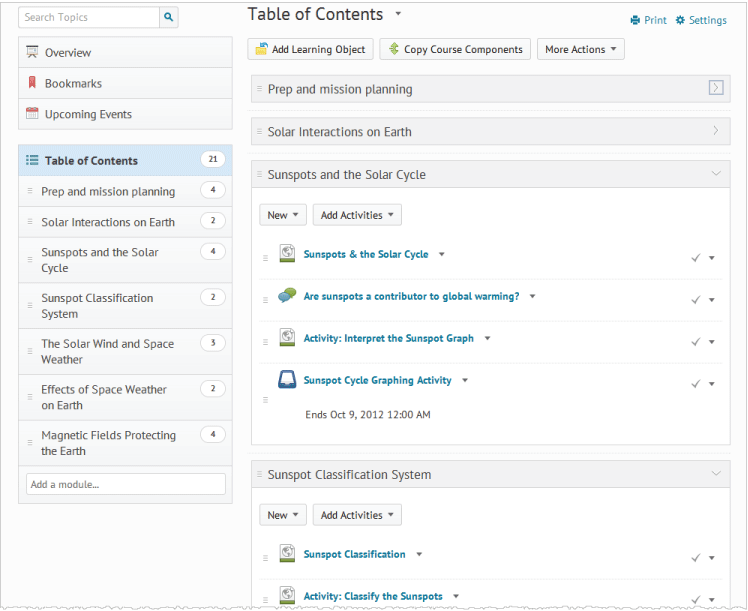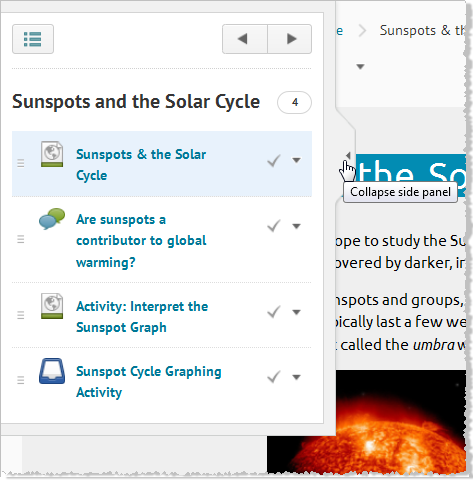
Content tool's Table of Contents page
When users access a course's Content tool for the first time, the first page they land on is the ![]() Overview. Use the Overview page to orient users to the course, content materials, and course expectations. You can insert course overview information using the HTML Editor beneath the Overview title, and you can add a file attachment by dragging a file from your computer onto the upload target, or by clicking
Overview. Use the Overview page to orient users to the course, content materials, and course expectations. You can insert course overview information using the HTML Editor beneath the Overview title, and you can add a file attachment by dragging a file from your computer onto the upload target, or by clicking ![]() Add an attachment from the Overview context menu.
Add an attachment from the Overview context menu.
Note If you decide not to add anything to the Overview, the ![]() Overview link and page is hidden from student view.
Overview link and page is hidden from student view.
The following file types display inline when added to Overview:
| Extension | File Type |
|---|---|
| HTM, HTML, MHT, MHTML | Web Document |
| RTF, PPT, PPS, PDF, DOC, DOCX, PPTX, XML, XLS, TXT, WPD | Text Document |
| JPG, JPEG, PNG, GIF, BMP, TIF, TIFF | Image |
| SWF, MPG, MPEG, RM, MP3, MP4*, M4V*, M4A*, AVI, WAV, RAM, ASF, MOV, RA | Media |
*The extensions MP4, M4V, and M4A are new. These extensions allow users to drag entire albums, Video Podcasts, and movies from iTunes.
Topics you bookmark appear in a list on the Bookmarks page. Click the ![]() Add Bookmark icon while viewing a topic to add it to your bookmarks list. The number beside the
Add Bookmark icon while viewing a topic to add it to your bookmarks list. The number beside the ![]() Bookmarks link indicates how many bookmarks you have.
Bookmarks link indicates how many bookmarks you have.
The Upcoming Events page lists course material due dates, start dates, end dates, and other course events for the next seven days. If you set availability dates or a due date for a course object, it appears in the Upcoming Events page and the Agenda view in the Calendar tool.
The dates listed on this page are not exclusive to Content topics; upcoming events include all events within the course from the Calendar tool. Click Course Schedule to view all past, current, and future course events. The number beside the ![]() Upcoming Events link indicates how many upcoming events you have.
Upcoming Events link indicates how many upcoming events you have.
The Table of Contents panel lists all modules available in your course. Click on a listed module to view and manage its details, topics, and sub-modules. You can also stay on the Table of Contents page to view and manage all modules and topics. Click on the ![]() Table of Contents link to access the Table of Contents page. This page enables you to view and manage all modules and topics. You can add new topics to existing modules by dragging and dropping files from your computer onto upload targets on the Table of Contents page, and you can also rearrange course materials by dragging and dropping topics between modules. See Creating and arranging your course content using drag and drop for more information.
Table of Contents link to access the Table of Contents page. This page enables you to view and manage all modules and topics. You can add new topics to existing modules by dragging and dropping files from your computer onto upload targets on the Table of Contents page, and you can also rearrange course materials by dragging and dropping topics between modules. See Creating and arranging your course content using drag and drop for more information.
The number beside each module name in the Table of Contents panel listing indicates the number of topics you have set completion tracking for. The number beside the ![]() Table of Contents link indicates the total number of topics you have set completion tracking for. Use the number totals to determine the task load being put on students per module.
Table of Contents link indicates the total number of topics you have set completion tracking for. Use the number totals to determine the task load being put on students per module.
You can access content through a smaller version of the Table of Contents within a topic by opening the collapsible side panel, which only shows the contents of one module at a time. Click or swipe the side tab handle to open the side panel.
Note The swipe-to-open action for the collapsible side panel is not available on the Nexus 7 device.
Browse through modules by clicking the ![]() Previous module or
Previous module or ![]() Next: [module name], or click the
Next: [module name], or click the ![]() Go to Table of Contents icon to return to the Table of Contents page.
Go to Table of Contents icon to return to the Table of Contents page.

Click or swipe the tab handle to open the collapsible side panel within a topic